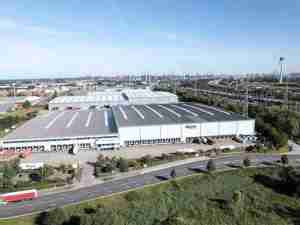Important milestones in 2011 are the start of construction work on the quay wall for the APMT container terminal (January), the delivery of the site to container stevedoring company RWG so that it can set up its terminal (spring) and the construction of the infrastructure bundle (road, rail, cables and pipelines) to connect Maasvlakte 2 to the existing port infrastructure. This infrastructure bundle will be situated between the Slufter and Distripark Maasvlakte.

Blockbuster figurehead of Maasvlakte 2
On the northwest side, Maasvlakte 2 will have a type of sea defence that is completely new to the Netherlands: a stony dune, in front of which there will be a dam of large concrete blocks to form a breakwater. To position the biggest stones and the concrete blocks, PUMA designed a unique crane: the Blockbuster. This was assembled on site, tested exhaustively and recently started work on the sea defences.
The Blockbuster is a modified version of the so-called ‘E-crane’, which can position 40-tonne concrete blocks up to 50 meters from the heart of the crane with an accuracy of 15 cm. This precision is required to give the block dam a semi-open structure, so that the wave energy is absorbed. The sea defences must be able to withstand storms which only occur once every 10,000 years. The Blockbuster weighs around 1200 tons, has a counterweight of 360 tons and moves on three double sets of caterpillar treads.
Trial period
The Blockbuster was delivered and the trial period began during the summer. The engineers from PUMA conducted tests with the various grabbers: for the 40-tonne concrete blocks, a special clamp was developed; the large chunks of hydraulic engineering stone are positioned using a polyp grab. The accuracy with which the crane works and the survey equipment that measures the Blockbuster’s operations were also tested exhaustively.
During the trial period, the crane operators were also given induction training. Although most of them were already very experienced in working with this type of crane, it is a different thing to operate a crane of this size and lift loads of 40 tons. The ‘final exam’ consisted of building a trial section ‘blind’: with closed blinds, the operators built a 50m block dam using only the information on the screen of the ‘crane monitor system’.
At the beginning of October, the Blockbuster drove onto the new land, its first task being to build temporary protection for the hard sea defences in the making. The aim of this is to ensure that as little sand as possible is eroded and as few stones as possible are washed away during the approaching stormy season. It is from this path that the blocks will be positioned in the final profile.
Stone dumping vessels, dumpers and shovels
On the southwest side, Maasvlakte 2 will have a soft sea defence of dunes and beach. On the northwest side, the waves can be stronger, however, and there is less room, due to the nearby navigation channel, to create a gradual slope. For this reason, it was decided to create a hard sea defence stretching 3.5 km made up of ‘stony dune’ wit









